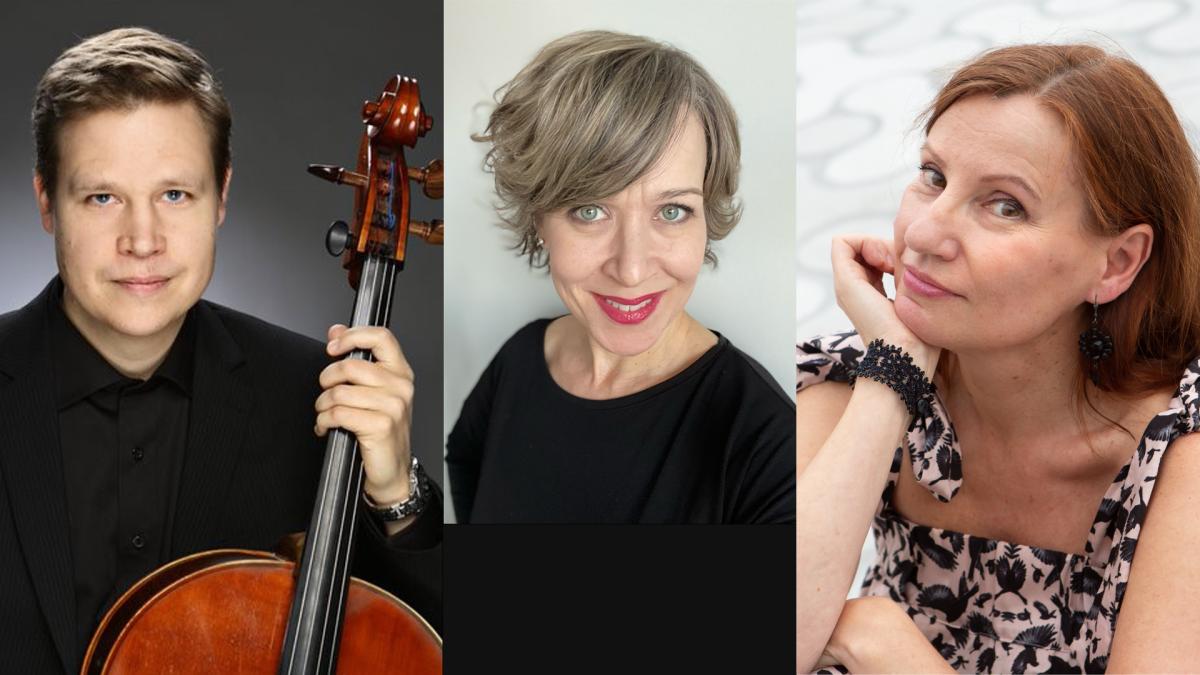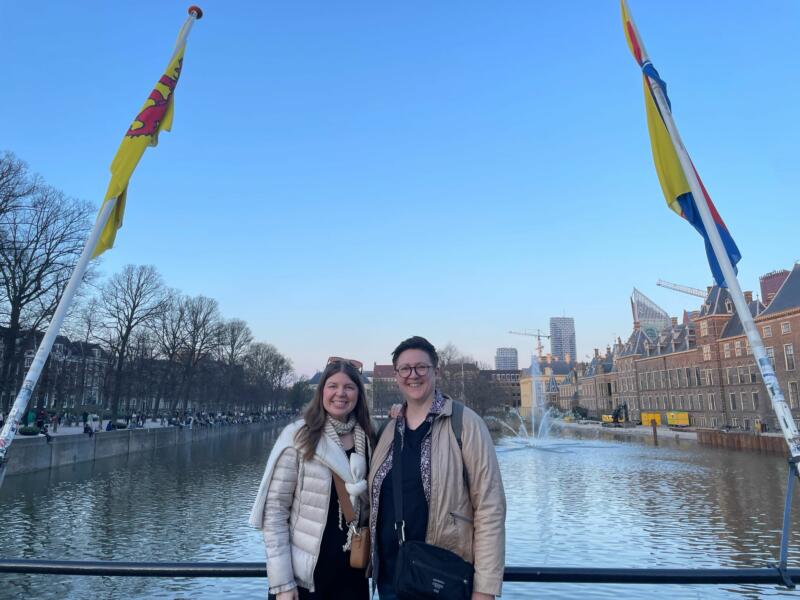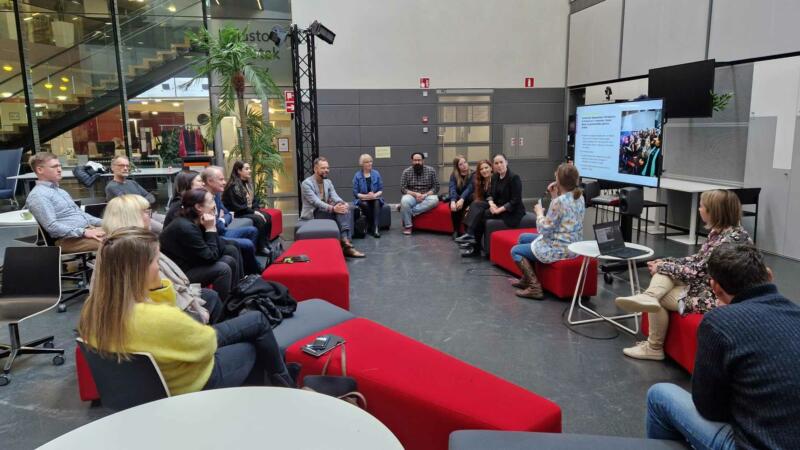A mirror from The Hague – building collaboration in music education
When three teachers from the Sibelius Academy of Uniarts Helsinki were invited to assess final examination performances at the Royal Conservatoire in The Hague, they encountered new evaluation cultures, bold programme choices and surprising artistic combinations.

Arts teacher in early music Elina Mustonen, classical vocal music lecturer Hanna-Leena Haapamäki and cello music lecturer and head of the Strings department Erkki Lahesmaa visited The Hague in spring 2025 to serve as external examiners for student degree concerts at the Koninklijk Conservatorium Den Haag.
The visit was part of the IN.TUNE university alliance, in which eight European arts universities collaborate to develop future-oriented education, high-level research and flexible mobility across institutions.
For Mustonen, Haapamäki and Lahesmaa, the experience offered not only a glimpse into the everyday life of another leading music academy but also a mirror for reflecting on their own practices. In this interview, they share their insights into international assessment work and what it revealed about music education today.
What was it like to observe and assess students’ final performances in an international environment?
Elina: I assessed bachelor’s and master’s concerts in the Early Music department, focusing on harpsichord and early keyboard instruments. Serving as an examiner gives you a fascinating cross-section of what’s happening right now in another conservatoire.
It’s also inspiring to hear how colleagues and former classmates speak and think about music today. Even though there’s little time for anything beyond assessment, those encounters bring a great deal of energy to my own work.
Hanna-Leena: I was part of the vocal music panel, assessing a total of ten degree concerts at both bachelor’s and master’s levels. I knew it would be an intense week, but the excellent orientation and clear assessment criteria helped with preparation.
As the only external member on the board, my role was to open the discussion in each evaluation. The atmosphere among the vocal teachers was collegial and constructive, which made the experience very positive.
Erkki: For me, assessing the final cello concerts was eye-opening and inspiring. It’s always interesting to get to know different academic environments and hear local students’ performances and the teachers’ evaluations. Even in today’s globalised world, every country’s education system retains its distinctive features.
How did the collaboration come about?
Elina: We’ve collaborated with The Hague Conservatoire before – between 2014 and 2016 I was also invited to assess lower-level degrees and doctoral projects. In 2019, I took part in the preparation of Purcell’s The Fairy Queen opera, which allowed me to draw on my background in acting and my special expertise in the connection between Shakespearean theatre and music.
Hanna-Leena: Our Lecturer of Lied, Keval Shah, has long-standing connections with The Hague, and through him we heard that the Head of the Vocal Department was interested in collaboration with Uniarts Helsinki.
Erkki: The Conservatoire’s Vice Principal, Martin Prchal, invited me to join the assessment panel for the final concerts. He’s a cellist himself, and I’ve known him for many years.
How do the assessment practices at the Sibelius Academy compare with those at The Hague Conservatoire?
Elina: The biggest difference is that in our Early Music department we don’t give numerical assessment at all – only verbal feedback. In The Hague, each examiner first filled in an assessment form with individual scores before a joint discussion. The marks were reviewed anonymously, averaged, and then the student received a brief written summary.
At the Sibelius Academy, the student is present throughout the feedback session. We start by asking for the student’s own reflections, and then engage in a dialogue where feedback is deepened together. However, a collegial and respectful atmosphere is central to both systems – students are listened to with genuine appreciation.
The panel composition also differs: in Finland, assessors are usually teachers from within the institution, while The Hague often invites external examiners from other countries. They really value the outside perspective – the kind I was able to bring to the discussions.
Hanna-Leena: The feedback sessions in The Hague are much shorter than at the Sibelius Academy. As Elina described, the board discusses the performance behind closed doors and then invites the student in to hear a summary. At home, our feedback sessions are much longer – up to 45 minutes – and the student is part of the whole dialogue.
The actual assessment criteria were very similar, focusing on technical and artistic skills, interaction, and stage presence, even if we structure the categories a little differently.
Another difference was the role of the student’s own teacher. In The Hague, the teacher-in-charge also takes part in forming the grade, whereas in Finland we make the final decision without their presence.
Erkki: In principle, the assessment process is quite similar. The main differences are the use of an external examiner and the presence of an administrative representative who delivers the compiled feedback to the student. At the Sibelius Academy, we as the panel members give the feedback directly ourselves.
What aspects stood out to you in the students’ performances or in the assessment process?
Elina: The Early Music department in The Hague is larger than ours, and the range of instruments is broad. The master’s concerts were also longer: in one evening, a student might perform on five or six instruments, both solo and in ensemble.
The concerts were designed as cohesive artistic works. Lighting, transitions and staging formed a deliberate dramaturgy where every detail supported the whole. In one concert, a student integrated music with mathematics and computer science – not superficially, but in a way that kept the music at the centre.
Students there are given the space and tools to realise their ideas boldly, from lighting design to conceptual thinking. It nurtures creativity, prepares them for professional life and makes the concerts true artistic experiences. That’s something I want to encourage in my own students as well.
Hanna-Leena: The open-minded approach to programming was also evident in vocal music. The content wasn’t limited by style or language – the only fixed frame was the duration, which was longer than ours.
Students could build their concerts entirely around their own interests and strengths, which meant that individual artistic profiles emerged already at bachelor’s level. The concerts included a wide range of chamber music settings, Early Music works with period instruments, lots of ensemble repertoire and interdisciplinary elements such as dance, electronic soundscapes and lighting design.
As Elina said, this kind of holistic programming mirrors real working life. Few singers build careers exclusively in opera, Lied or as concert soloists; professional life demands flexibility, networking, and the ability to work across formats.
That said, such complete freedom of form can also allow some students to avoid demonstrating certain core skills in vocal music.
Erkki: I agree with both Elina and Hanna-Leena. The concert programmes were remarkably imaginative and individual – I heard many works for the first time. The creative use of chamber ensembles within the same concert was also impressive, offering a multifaceted view of each student’s artistry.
What reflections did the visit spark on international collaboration in music education?
Elina: In our Early Music department, we’ve valued international connections for decades – this visit was another inspiring window into that world. Collaboration works best when it grows from genuine needs.
These visits bring fresh ideas that can easily be adapted into one’s own teaching. Sharing one’s expertise in turn enriches the international community – it’s a clear win–win.
I also encourage students to seek international experiences. They gain invaluable perspective, and most of them do take part in exchanges at some point, bringing back new ideas and impulses for their artistic growth.
Hanna-Leena: I had previously taken part in the Royal Conservatoire’s Artist as Teacher training before it became part of the IN.TUNE alliance educational offering, but this was my first experience as an external examiner.
It confirmed my belief that Finland has a lot to offer. Our music education system is very well structured, starting from basic arts education, and our assessment processes are systematic and transparent. I was even complimented for the clarity and focus of my feedback – something I believe reflects the logical and pedagogically sound approach of Finnish music education.
Erkki: Beyond teacher exchanges, international collaboration should also include joint curriculum development, shared courses and inviting external experts – such as for assessment work like this.
How did the visit influence your own teaching – or your view of assessment?
Elina: I’ve long thought that not giving numerical grades can actually sharpen the quality of verbal feedback. I’ve seen situations where the student only remembers the grade, not the discussion that led to it.
In the arts, assessment is inherently different from sports where you “jump higher or further”. That’s why numbers can sometimes feel artificial. In The Hague, though, the feedback was encouraging and respectful. I didn’t ask what added value they see in numerical grading – but I’m curious.
Hanna-Leena: I would love to see more room for students’ individual interests and strengths already earlier in their studies. At the moment, clearly framed assessment requirements tend to steer the structure of concerts quite tightly, and true artistic freedom often comes only at master’s level.
It was eye-opening to see how programming is approached elsewhere – in international environments, the field of art music is viewed much more broadly than through the lens of the European tradition alone.
In multicultural institutions, students bring music from their own backgrounds and cultures, including places whose art music we know very little about. It opens up the world of art music in completely new ways.
I would gladly take part in similar collaborations again. Working as an international examiner provides valuable perspective on what we do well and what we might learn from others in developing our own practices.
Erkki: Every visit influences one’s teaching. You hear individual students, and assessing or teaching them requires creativity. The conversations and reflections with local colleagues are also an important source of professional growth.
* * *
IN.TUNE
IN.TUNE is an alliance of eight European universities in the field of music and the arts. Together, the universities develop the quality, impact and international competitiveness of arts education and research in the long term. The European Commission has granted IN.TUNE funding for 2024–2027.
Read more about the alliance here.

